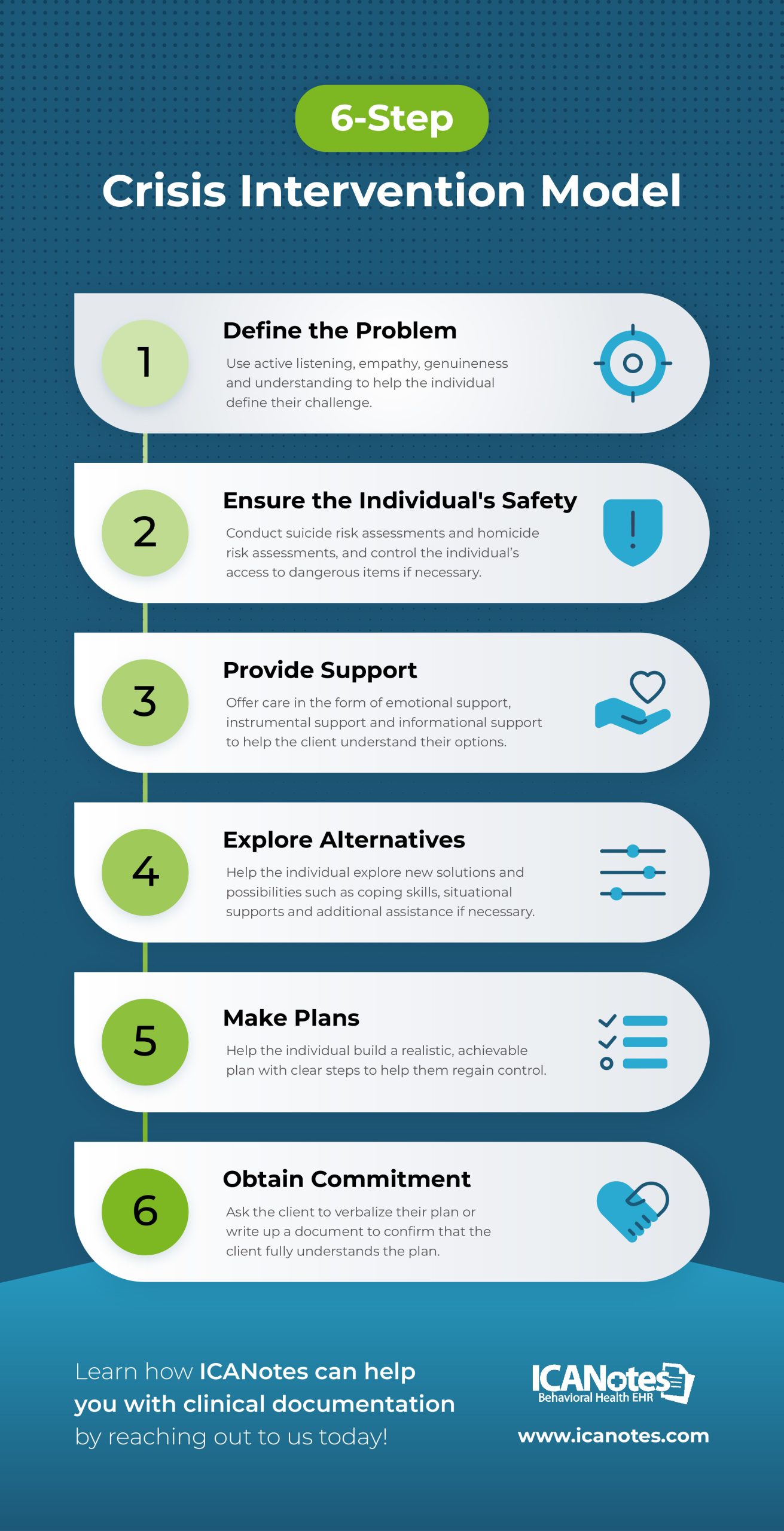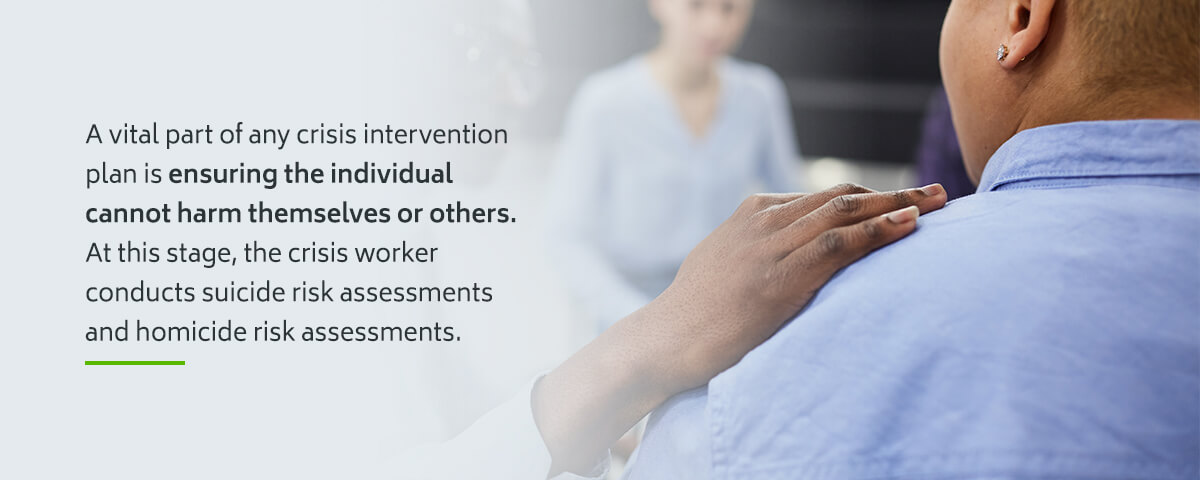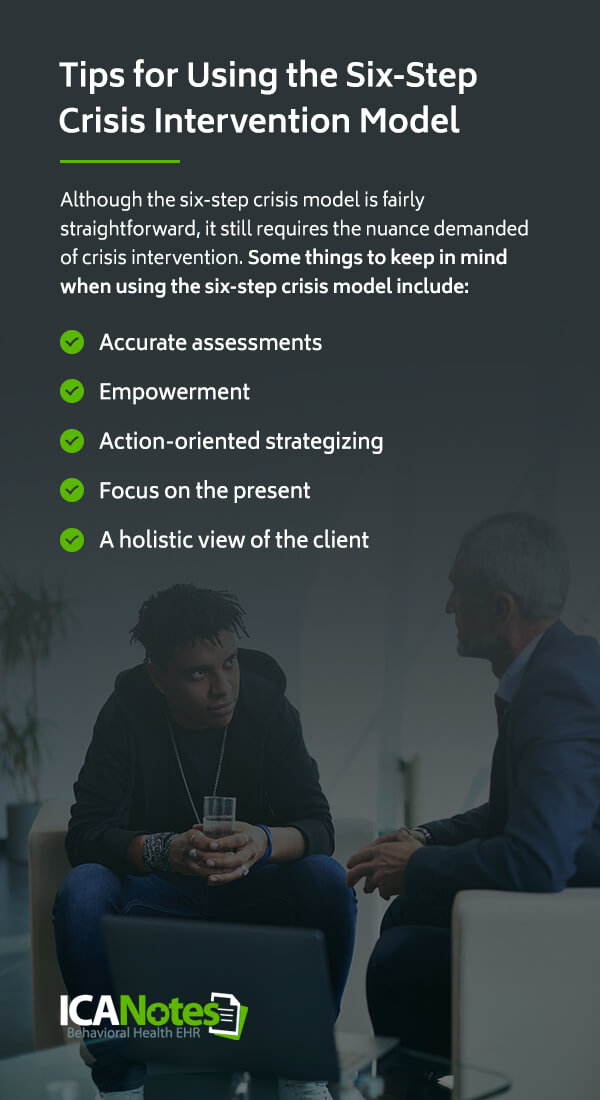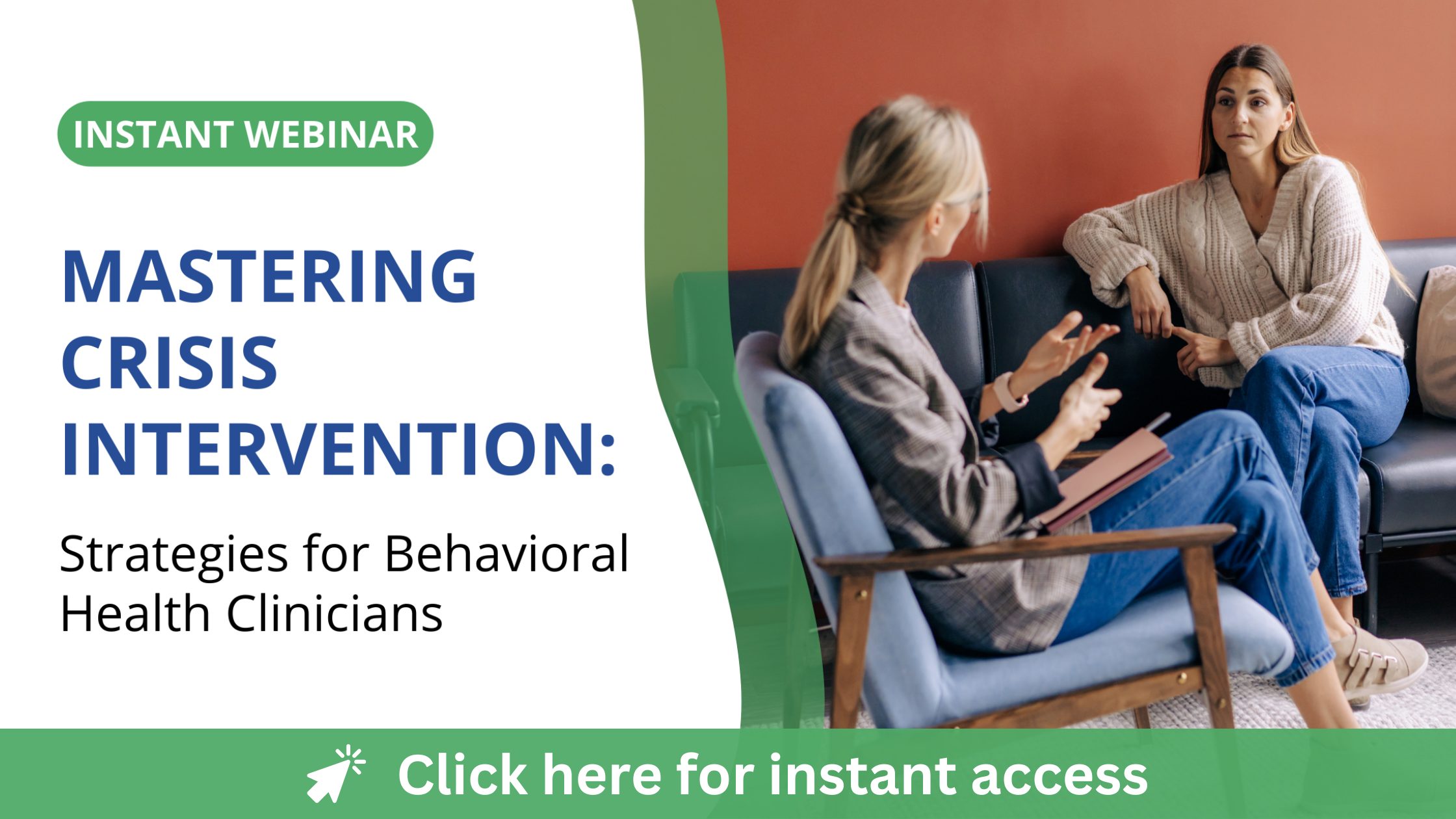Blog > Treatment Strategies > The Six-Step Crisis Intervention Model Explained
A mental health crisis can happen suddenly, leaving someone feeling overwhelmed or unsafe. In these moments, clinicians need a clear approach that protects safety and guides recovery. This article explains the Six-Step Crisis Intervention Model, a practical framework for defining the crisis, assessing risk, providing support, and planning the next steps. Using this model helps clinicians respond confidently and improve outcomes for people in crisis.

Last Updated: October 7, 2025


What You'll Learn
-
The six sequential steps of the Crisis Intervention Model (from defining the problem through obtaining commitment)
-
How to apply each step in real-world crisis situations (including listening vs. action phases)
-
Techniques for assessing safety, managing risk, and offering support in crisis
-
Methods to collaboratively explore alternatives and build a realistic recovery plan
-
Best practices for securing commitment and follow-through with clients
-
When and how this model compares to other crisis intervention frameworks
The Six-Step Crisis Intervention Model, developed by Richard James and Burl Gilliland, offers a proven structure to help de-escalate crises and restore psychological stability. By following a step-by-step process rooted in empathy, safety, and collaboration, clinicians can lead individuals out of acute distress and support their return to a functional baseline. This model is especially useful in clinical, community, and emergency settings where timely, skillful intervention is critical.
What Is Crisis Intervention?
Crisis intervention is a focused, time-sensitive approach used to help individuals regain stability after experiencing a psychological or emotional crisis. The goal is to reduce immediate distress, ensure safety, and connect the person with resources that support recovery. It is most often used in situations involving trauma, suicidal ideation, sudden loss, substance use, or acute mental health episodes.
This approach is grounded in crisis intervention theory, which explains how overwhelming events can disrupt a person’s ability to cope and function. When normal coping skills fail, timely intervention helps prevent long-term harm and supports a return to pre-crisis functioning.
What Is the Six-Step Crisis Intervention Model?
The Six-Step Crisis Intervention Model is a structured approach used by mental health professionals to help individuals manage and recover from a psychological crisis.
According to this model, a crisis occurs when someone experiences an event they perceive as overwhelming or intolerable. The situation exceeds their available coping skills and creates a sense of psychological imbalance.
The six stages of crisis intervention provide a clear process for evaluating the situation, offering support, and developing a recovery plan.
The six steps are divided into two phases:
- Three listening-focused steps: define the problem, ensure safety, and provide support.
- Three action-focused steps: examine alternatives, make a plan, and obtain commitment.
Clinicians assess the client's emotional state at every stage, listen actively, and adjust their response to meet the individual's immediate needs. The model combines empathy with action to help people in crisis regain control.
Step 1: Define the Problem
Step number one asks the crisis worker to define the problem. This first stage establishes a connection between the crisis worker and the client as they begin discussing the issue. To fully understand the situation and form a bond with the client, the crisis worker implements:
Active listening: Active listening requires fully focusing on the client, demonstrating acceptance, and removing biases. The crisis worker must understand the client's perspective without allowing their feelings to get in the way. This type of listening also helps improve the relationship between the two parties.
Empathy: Practicing empathy is about taking someone else's point of view and showing them you understand them. It asks you to remove any judgment or biases and accept the patient as a whole person, not define them by their current situation. It also requires being in the present and putting the other person and their feelings first. Empathy is essential throughout the six-step process, especially when establishing the relationship.
Genuineness: People can often tell when you aren't being genuine. In a crisis, this can quickly paint you as untrustworthy and break down the relationship between crisis worker and client. Speak genuinely but carefully and solidify your position as a trustworthy partner in their mental health.
Understanding: You also need to show the client you understand their situation. You may use language that confirms you understand the problem or relates to their issue somehow.
The crisis worker should look at the problem from the client's point of view. They should try to understand where the client is coming from and their available resources, such as coping skills or caring friends and family.

Step 2: Ensure the Individual's Safety
A vital part of any crisis intervention plan is ensuring the individual cannot harm themselves or others. At this stage, the crisis worker conducts suicide risk assessments and homicide risk assessments. You may evaluate factors like agitation or the client's potential for causing harm.
Another important step here is controlling the individual's access to dangerous items. These can be as clear-cut as firearms or as subtle as office supplies, like staplers and paper cutters. The client's location and the resources of the mental health crisis system will make a big difference in this step.
For example, an inpatient psychiatric client likely has far less access to harmful items than a client being treated through a mobile care unit. That client might be able to use a variety of dangerous instruments and lack supervision when the crisis worker leaves.
The crisis worker must help transition the client into a safe environment before they can work on the next steps.

Step 3: Provide Support
In the third step, the crisis worker shows the client that they accept and care for them. They'll discuss the problem and offer support to meet basic needs. These might come in the form of:
- Emotional support: The crisis worker must express emotional support through statements that illustrate empathy, trust, and care. Emotional support can also come from trusted friends and family.
- Instrumental support: Instrumental support refers to services and aid, like shelter and food. Fulfilling basic needs is a necessary prerequisite for the problem-solving that occurs in the next three action steps.
- Informational support: The crisis worker offers advice and suggestions. For example, you might teach the individual about healthy coping strategies or reassure them that many resources are available.
The goal of these supports is to set the person up so they can understand the options available for dealing with the situation.
Be ready when your clients need you most!
Download our Crisis Intervention Toolkit for Mental Health Clinicians—equip yourself with the essential tools to confidently navigate crisis situations in your practice. This toolkit is packed with evidence-based de-escalation techniques, guided questions for assessing suicide risk, and printable safety plans and coping tool worksheets.
Step 4: Explore Alternatives
As we switch gears into the action steps, step four is about finding new solutions and navigating possibilities. The crisis worker collaborates with the person in crisis to explore these options. If their coping skills are weaker, the crisis worker may need to offer more assistance at this step, but it's important to draw on assessments first to understand the client's capabilities.
Other elements the crisis workers might draw on during this step include situational support, such as people in the individual's life who care about them, or coping mechanisms that can help them through the situation so they can move into the problem-solving stage.
During this step, it's necessary to use and cultivate positive, constructive thinking patterns. The crisis worker may need to spend some time helping the client reframe their thoughts in more positive ways.

Step 5: Make Plans
With trust established and options explored, it's time to make a plan. During step five, the individual and the crisis worker continue to collaborate, building a plan with clear, concrete steps to help the client regain control. These plans must be realistic and achievable.
They should empower the client, making them feel like they can accomplish the tasks and take ownership of the recovery process. This step relies heavily on collaboration with the client because it helps them take control, using their existing resources and capabilities.
The individual's plan should be detailed and straightforward. It might involve referrals and resources like people or groups that can help the client, such as support groups, medical providers, or food banks.
Step 6: Obtain Commitment
The last step is to obtain commitment. Getting commitment might be as simple as asking the client to verbalize the plan or as complex as writing up a document and having both parties sign it. In either case, the crisis worker needs to confirm the client fully understands the plan and feels capable of following through.
The crisis worker should also make plans to follow up with the client. You can create a sense of accountability and, of course, help ensure the client's well-being. If the client needs further care, the crisis worker can also make referrals.
Examples and Applications of the Six-Step Crisis Intervention Model
Crisis intervention is an immediate, short-term response to mental, physical, emotional, and behavioral distress. It is not a long-term option like psychotherapy or similar treatments. The goal is to restore the person's functioning to what it was before the crisis and reduce the opportunity for long-term trauma. It aims to help the client access assistance, support, and resources that allow them to become stable.
When is the Six-Step Model Used?
The six-step model can be used in many situations, but some common triggers for crises include:
Family situations: Some family situations — like child or spousal abuse, unplanned pregnancy, or serious or chronic illness — can cause stress and lead to a crisis.
Economic situations: Financial strain from job loss, eviction, theft, medical expenses, gambling, or poverty can trigger many crises based on the sudden or chronic financial strain they create.
Community situations: An individual's community can also contribute to their mental state. For example, someone facing violence in their neighborhood, poor housing, or inadequate community resources might experience a crisis.
Significant life events: Some events often viewed as happy situations can paradoxically trigger crises. These might include marriage, the birth of a child, or a promotion at work. Other significant events, like raising a rebellious adolescent, losing a loved one, or seeing a grown child leave the nest, can also cause a crisis.
Natural elements: Plenty of natural disasters, such as floods, hurricanes, and fires, can trigger crises. They might involve harm to a loved one or the destruction of possessions, creating states of distress. Even seemingly minor events, like a bout of gloomy or hot weather, can put someone into a crisis state.
Identifying When Crisis Intervention Is Needed
Some signs someone is in crisis and may need the help of an intervention strategy include:
- Feelings of hopelessness
- Anger
- Difficulty eating or sleeping
- Depression
- Denial
- Neglected personal hygiene
- Isolation
- Apathy
- Anxiety
Symptoms can vary widely, but remember that a crisis intervention plan is generally warranted when the situation exceeds the patient's resources and coping skills.
Example of Crisis Intervention in an Outpatient Setting
A client at an outpatient behavioral health clinic arrives in crisis after a sudden breakup and eviction. The clinician begins by defining the problem, allowing the client to express their distress. After confirming the client is not at immediate risk, the clinician offers emotional support and validation.
They explore alternatives like temporary housing, transportation help, and supportive contacts. Together, they create a short-term plan, including a shelter referral and a follow-up appointment. The client agrees to the plan, completing the process by committing to next steps.
This scenario shows how the Six-Step Crisis Intervention Model can stabilize someone in acute distress and connect them to essential resources quickly and effectively.
The Benefits of the Six-Step Crisis Intervention Model
Crisis intervention is a powerful tool. An unmanaged crisis can lead to significant psychological stress, which can link to major depressive disorder or other mental health conditions. Crisis intervention has proven efficacy in preventing mental illness from developing and helping to treat patients currently suffering from one.
Studies have even shown that emergency departments with crisis intervention teams saw reduced return visits and shorter durations of stay. They reduced the number of repeat admissions and found the interventions were more effective than standard care in improving the patient's mental health.
We know crisis intervention can be critical to improving psychiatric case outcomes. The six-step model emphasizes two distinct components of helping someone with a problem: listening and taking action. It covers vital steps of crisis intervention, like creating a bond with the client, identifying resources, and guiding them toward a healthy solution. It also offers a clear, systematic approach that helps ensure the crisis worker accomplishes the tasks that can help the client.
Key Strategies and Skills in Crisis Intervention
The Six-Step Crisis Intervention Model provides structure, but successful outcomes depend on how strategies for crisis intervention are applied in real-world settings. Crisis work requires clinical skill, empathy, and the ability to adapt strategies to each unique situation. The following strategies and skills are central to effective intervention:
Accurate assessment: Assessments guide every decision in crisis intervention, from risk evaluation to treatment planning. Because each person and situation is unique, generalizations can lead to errors that compromise safety and care. Using structured, evidence-based assessment tools helps clinicians accurately gauge risk, identify needs, and tailor responses.
Empowerment: A crisis often leaves individuals feeling powerless. One of the model’s core goals is to restore a sense of control through collaboration. By involving clients in problem-solving and validating their strengths, clinicians empower them to take ownership of their recovery. Even when firm guidance is required, the individual should contribute as much as possible to decision-making.
Action-oriented problem-solving: Unlike long-term therapy, crisis intervention focuses on the immediate situation. Clinicians should anticipate how the crisis is likely to affect the client, recognize potential risks, and guide the client toward practical solutions. Each step of the model should move the person closer to stability through concrete, achievable actions.
Focus on the present: Crisis work emphasizes immediate relief and stabilization. Clients need coping strategies they can use right away — such as breathing techniques, safety planning, or access to supportive resources — rather than long-term interventions that may take weeks or months to show results.
Holistic perspective: Finally, clinicians must view the client as a whole person. Emotional, cognitive, behavioral, and social factors all play a role in how someone experiences a crisis. Addressing only one aspect risks leaving other critical needs unmet. A holistic approach ensures the intervention supports not just immediate safety but also the broader context of the client’s life.

Other Crisis Intervention Models to Know
While the Six-Step Crisis Intervention Model is one of the most widely used methods of crisis intervention, several other models also guide clinicians in responding to individuals in acute distress. Each has unique strengths, and familiarity with multiple approaches allows mental health professionals to adapt to different settings and client needs.
Roberts' Seven-Stage Crisis Intervention Model
Developed by Albert Roberts, the Seven-Stage Crisis Intervention Model is a trauma-informed framework that emphasizes a systematic, step-by-step process. The seven stages include assessment, establishing rapport, identifying major problems, exploring feelings, generating coping strategies, creating an action plan, and following up. This model is widely used in clinical, community, and emergency settings where a thorough evaluation and structured response are required.
The ABC Model of Crisis Intervention
The ABC Model, developed by Kristi Kanel, is a three-step approach designed for brief crisis encounters, such as hotline or emergency calls. This model emphasizes rapid assessment and intervention, guiding clinicians through the immediate needs of individuals in distress.
The three stages are:
A — Achieving Rapport
Establish a quick and genuine connection to build trust and create a safe space for disclosure.
B — Boiling Down the Problem
Identify the immediate crisis trigger and clarify the core issue affecting the client’s current functioning.
C — Coping
Introduce practical coping strategies and support systems that the client can access right away.
This model is particularly effective in time-limited settings, offering a focused framework to stabilize emotions, prioritize concerns, and initiate short-term relief.
The SAFER-R Model
Created by George Everly, the SAFER-R Model is widely used in emergency services and disaster response. This model is designed for high-stress, high-stakes environments where quick, structured intervention is critical to restoring psychological stability.
The six steps are:
S — Stabilize
Reduce immediate distress and ensure the individual is physically and emotionally safe.
A — Acknowledge
Validate the individual’s experience and emotional response without judgment.
F — Facilitate Understanding
Help the person make sense of the event and their reactions to it.
E — Encourage Coping
Reinforce existing strengths and suggest practical strategies for managing the current stress.
R — Recovery or Referral
Support the return to baseline functioning or connect the individual with ongoing professional resources.
This model provides a clear, action-oriented roadmap for crisis intervention professionals operating in acute trauma scenarios, ensuring both immediate support and long-term stabilization when needed.
Lerner and Shelton’s 10-Step Acute Traumatic Stress Management (ATSM) Protocol
Designed for trauma-focused care, the ATSM protocol provides a detailed guide for emergency responders and clinicians working with individuals experiencing acute stress reactions. It emphasizes safety, emotional grounding, medical support, and preparation for future coping.
Why These Models Matter
Crisis situations vary widely, from natural disasters to personal trauma. Having multiple frameworks to draw upon allows clinicians to tailor their response to the specific context, available resources, and client needs. While the Six-Step Model provides a strong foundation, integrating insights from Roberts, Kanel, Everly, and Lerner & Shelton expands a clinician’s ability to respond flexibly and effectively.

How ICANotes Supports Your Crisis Intervention Workflow
Applying the Six-Step Crisis Intervention Model requires accurate assessments, complete documentation, and reliable follow-up. Without the right tools, clinicians can lose valuable time to paperwork or risk incomplete records that affect care and compliance.
ICANotes simplifies crisis documentation with a cloud-based EHR built for Behavioral Health. Inpatient teams, outpatient clinics, and mobile crisis units can complete assessments in minutes, track progress, and ensure every step is documented. Integrated features for billing, ePrescribing, and scheduling keep workflows connected and payer-ready.
By reducing administrative burden, ICANotes lets clinicians focus on what matters most: supporting clients in crisis with timely, patient-centered care.
Start Your 30-Day Free Trial
Experience the most intuitive, clinically robust EHR designed for behavioral health professionals, built to streamline documentation, improve compliance, and enhance patient care.
- Complete Notes in Minutes - Purpose-built for behavioral health charting
- Always Audit-Ready – Structured documentation that meets payer requirements
- Keep Your Schedule Full – Automated reminders reduce costly no-shows
- Engage Clients Seamlessly – Secure portal for forms, messages, and payments
- HIPAA-Compliant Telehealth built into your workflow
Complete Notes in Minutes – Purpose-built for behavioral health charting
Always Audit-Ready – Structured documentation that meets payer requirements
Keep Your Schedule Full – Automated reminders reduce costly no-shows
Engage Clients Seamlessly – Secure portal for forms, messages, and payments
HIPAA-Compliant Telehealth built into your workflow
Frequently Asked Questions
About the Author
Dr. October Boyles is a behavioral health expert and clinical leader with extensive expertise in nursing, compliance, and healthcare operations. With a Doctor of Nursing Practice (DNP) and advanced degrees in nursing, she specializes in evidence-based practices, EHR optimization, and improving outcomes in behavioral health settings. Dr. Boyles is passionate about empowering clinicians with the tools and strategies needed to deliver high-quality, patient-centered care.









